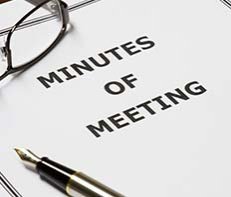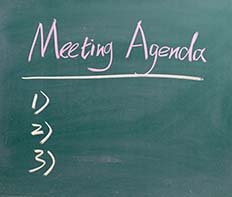What are Meeting Minutes?
Minutes of Meeting describe specify what was discussed and decided in a meeting, providing a permanent record of the meeting for future reference. They tend to include an overview of the structure of the meeting, including.
- Those present and those who could not attend
- A list of the agenda items/topics
- Summary of discussion for each agenda item
- The actions people committed to
- Summary of any decisions made
Meeting Minutes, are generally distributed shortly after the meeting ends and are confirmed as accurate at the start of the next meeting.
Why is it important to have Minutes?
Minutes are a record of the meeting for those that were at the meeting and they are an important source of information for those who were not there. There are two key reasons for keeping minutes of your meetings
- Memories are unreliable. It is useful to have a written record of the meeting, including actions and decisions. The minutes are a good reference for attendees and serve to refresh memories.
- The minutes are a communication tool for sharing the outcomes of the meeting with people who were not able to attend.
What tasks are involved in taking minutes?
Prior to the meeting, one of the attendees is normally designated as the minute taker.
The minute taker generally completes the following tasks
- Taking notes during the meeting
- Formalising or tidying up these notes after the meeting
- Distributing the minutes to the relevant people
- Filing minutes for future reference
Note: Minutes are often recorded during the meeting on laptop computers.
Note: If you wish to tape record the meeting. You need to ask all meeting participants for their approval before recording the meeting.
What should you write down?
When taking minutes you should record the following
- the start and end time of the meeting
- attendees and apologies
- amendments to previous Minutes of Meeting
- actions,
- decisions made
- summarise discussion
- items to be held over for further discussion.
A few tips to assist you with producing good minutes
- It is impractical to write everything down, so don’t try
- At the end of each agenda item feel free to ask what should be minuted
- Record all decisions and actions for inclusion in the minutes
- Produce concise minutes
The minutes should be distributed within a few hours of the meeting finishing. They can be concise, in plain English and are not required to be grammatically correct.
Tips for Taking Minutes
Taking minutes is easier in well managed meetings than in unstructured meetings, you will find these tips will assist you to take good minutes
- Ask for clarification, if
- lots of different suggestions are being made about what to do
- the discussion jumps from topic to topic without conclusion
- There are long discussions with no obvious conclusion
- You are also participating in the meeting and have forgotten to take notes
- It is not clear what decision was made
- Prepare a skeleton of your minutes prior to the meeting, possibly with draft motions for the more procedural items.
- Follow the same formatting and numbering in the Agenda.
- Use headings
- Use the past tense, the minutes are distributed after the meeting
- Do not include first pronouns, such as ‘we’ and ‘our’ and use passive voice.
- Proofread your draft minutes carefully
Tips for Formal Meetings
- Ensure there is a quorum
- Note when participants arrive and/or leave.
- Write the exact wording of all motions, movers and seconders names, any amendments and resolutions and whether they were lost or carried.
It is also a nice extra touch to
- Alert participants to any tasks assigned to them (even though they were at the meeting and know what happened).
If required get your draft minutes approved
- Provide copy of draft Minutes to the authorizer
- Amend Minutes of Meeting as required
- Submit final Minutes of Meeting for final approval and signature
- Distribute the Minutes of Meeting to those who attended the meeting and those who sent apologies
Definitions
The minute taker is the person responsible for preparing the Minutes of Meeting.
Quorum – The minimum number of the meetings regular participants that need to be in attendance for the meeting to legitimately make decisions. This is normally half of the meetings participants plus one
A stakeholder is a person who should be interested in the meeting’s outcomes.
An action is a task which should be completed by one of the meeting participants as a result of meeting discussions. To properly record action items you will need to record
- what needs to be done
- who is responsible
- when the task needs to be done
Apologies are notifications from meeting participants indicating that they are unable to attend the meeting.
A motion is a formal proposal made by a meeting participant.
Free Templates
Additional Resources for Meeting Minutes
Wikipedia - Meeting minutes
Wild Apricot - How to write effective minutes
WikiHow - How to take meeting minutes
Effective Meetings - How to record useful meeting minutes






